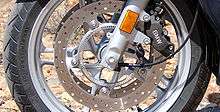Gilmer belt
Gilmer belt is a trade name for a belt used for transferring power between axles in a machine. The Gilmer belt was originally sold by the L. H. Gilmer company in 1949,[1] and represents one of the earliest toothed belt designs. The belt uses trapezoidal teeth to engage matching grooves on toothed pulleys in order to maintain synchronicity between moving parts.[2]
The Gilmer name is still used by enthusiast circles, including automotive and RC hobbyists. However, the L. H. Gilmer Company became a wholly owned subsidiary of Uniroyal in 1940[3] and Uniroyal Power Transmission was purchased and absorbed by Gates Rubber Company in 1986.[4] Gates no longer sells belts under the Gilmer name.
Applications
- Radio controlled cars (especially sedans), in place of a chain or a driveshaft system.
- Automotive valvetrain applications, such as timing belts for driving the camshafts,
- Motorcycle final drives.
- Computer printers with moving print heads may use Gilmer belts to control the motion of the print head(s).
See also
References
- ↑ Synchronous Belts - Part 1 (PDF), Gates Rubber Company
- ↑ Definition of a Gilmer belt, Isky Racing Cams, retrieved 2011-01-16
- ↑ Timing Belts (PDF), BSC Solutions
- ↑ "Uniroyal to Sell Unit to Gates", The New York Times, 1986-05-22
This article is issued from Wikipedia - version of the 9/26/2016. The text is available under the Creative Commons Attribution/Share Alike but additional terms may apply for the media files.
